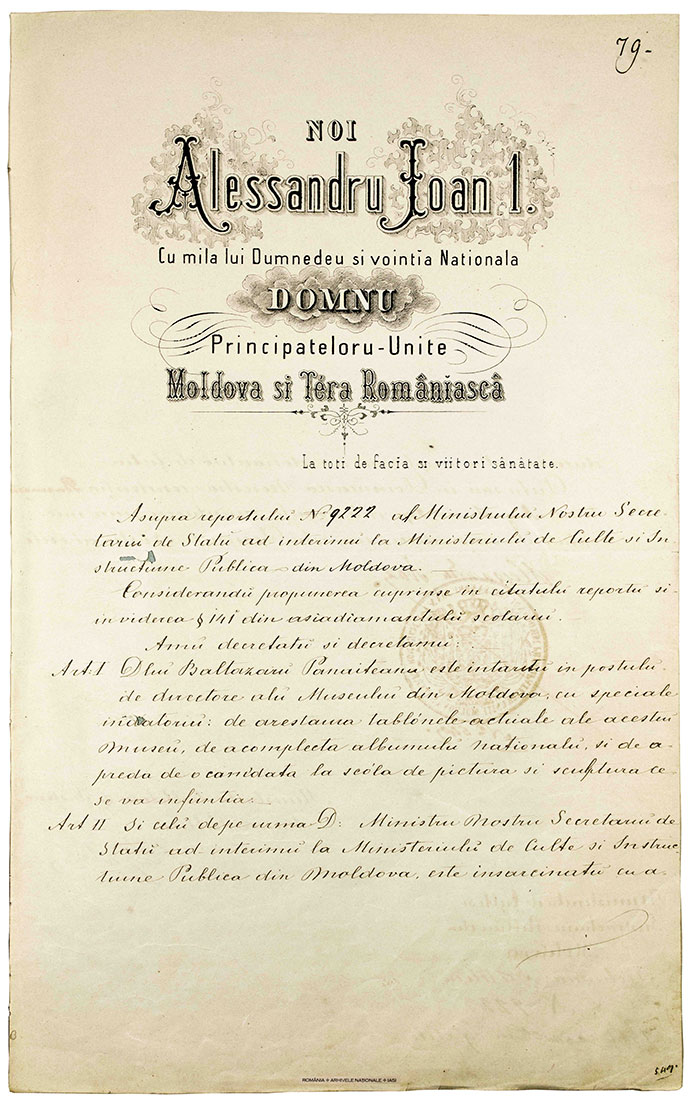 The art education from Iaşi makes its appearance in the second half of the 19th century, when the authorities saw the clear need to initiate an organized higher education process for art. The initiative belonged to the great scholar and politician Mihail Kogălniceanu, then minister for Religious Affairs and Public Education of Moldavia. In a report addressed to the authorities at the time, he defines the role of art in the formation and education of a nation: “arts cannot thrive unless they are both protected and encouraged by the government”.
The art education from Iaşi makes its appearance in the second half of the 19th century, when the authorities saw the clear need to initiate an organized higher education process for art. The initiative belonged to the great scholar and politician Mihail Kogălniceanu, then minister for Religious Affairs and Public Education of Moldavia. In a report addressed to the authorities at the time, he defines the role of art in the formation and education of a nation: “arts cannot thrive unless they are both protected and encouraged by the government”.
On October 1st 1860 , the first Ruler of the United Principalities, Alexandru Ioan Cuza, signs the decree for the foundation of the first higher education institution in Romania – the Music and Declamation School in Iaşi. 26 days later, with the signing of the decree for the foundation of the University, the School for Sculpture and Painting and the National Painting Museum are born.
On October 6th 1864 , Cuza approves the Charter for the Music and Declamation Conservatory , with two schools, one in Iaşi and one in Bucharest. On October 23 rd the same year, the Charter for the National Schools of Fine Arts is approved, establishing the departments: painting, sculpture, gravure, architecture and the art of landscape architecture; the charter was later revised in 1869 and 1883 .
The first Charters were improved constantly, the study area widening substantially over the years. In this respect, the year 1907 marks an important stage, this being the year when the department of musical theory, together with those of canto, instruments and drama. The chamber music concerts, the theatre performances, as well as the micro-seasons of the symphonic orchestra, their number and especially their quality, proven by the approved repertoire, demonstrate that the Iaşi Conservatory itself had come of age.
Between 1917 and 1918 , George Enescu, a top-ranking personality on the national and international music scene, reunites under his conducting baton, within a symphonic orchestra of exceptional value, all the renowned musicians of Iaşi, most of them professionals working at the Music and Declamation Conservatory, whose honorary direction he accepts.
In 1931 , the Conservatory and the School of Fine Arts are elevated to the rank of Academy through a decree given by the renowned historian and politician Nicolae Iorga. In the same year George Enescu accepts the proposal that the Academy of Music and Drama in Iaşi bear his name, and he is appointed, at the initiative of the teaching body, honorary Rector for life.
In 1948 , the education reform brings together the art education institutions under one roof, that of the Art Institute, which had in Iaşi, the Music, Drama and Fine Arts Faculties.
The interval 1950-1960 influenced in a negative manner the natural development of the art education in Iaşi, because of misdirected institutional reorganisations that separated the art domains, their subsequent evolutions being different one from the other.
The Music Conservatory, re-established in 1960 , becomes, little by little, a pole for the rest of the domains, the professional commitment of its staff warranting a special place for it in the national perimeter. In 1977 , the fine arts are included in the structure of the Conservatory and between 1990 and 1991 , drama is also included. The year 1992 re-unites the three domains of art under the name the Academy of Art “George Enescu”.
The great transformations taking place in Romania after 1989 prompted a new analysis of the art education, the cultural centre in Iaşi reaching again the parameters it deserved in light of its historical evolution.
In 1997 the institution receives, through a decree of the Romanian Government, the name of «University of Arts “George Enescu”» and it organizes through its structure the three main artistic branches in three specialised faculties: the Faculty of Performance, Composition and Music Theory Studies, Faculty of Theatre, Faculty of Visual Arts and Design.
In University of Arts “George Enescu” Iasi, there were concerns and to provide pedagogical training of students being trained at the same time teaching career. Such, Department for Teachers Education (DTE) was founded in 2002 by O.M. no. 4861 of 11 November 2002 by the Ministry of Education. Within this activity is carried out initial and continuous training, pedagogical and teaching students and graduates of higher education who are dedicated to the teaching profession disciplines curricular area Arts: Music, Visual Arts, Theatre and Choreography.
